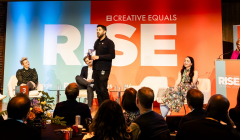
Are we leaving men and boys behind?
At Creative Equal’s RISE event, industry leaders consider how to reframe boys and men in marketing

Brands must have true local understanding to create culturally sensitive and accurate work

When thinking about brand ‘localisation’, the first port of call is usually a locally inspired visual layer. This might be an aesthetic that uses locally sourced materials, bespoke elements that employ artisanal skills from the area; touchpoints animated with landmarks or cultural reference or motifs bearing historical meaning. Whilst this is great when it is executed with the right dose of relevance and cultural sensitivity, there are further key things brands can start doing beyond this that will build real ‘fandom’.
A better understanding of cultural nuances and local habits not only helps brand meet expectations but can push them to innovate and create service rituals that are purposeful and memorable- ones that can adapt to changing needs, missions and mindsets.
Siu-Lan Choi, ECD, Household
A better understanding of cultural nuances and local habits not only helps brand meet expectations but can push them to innovate and create service rituals that are purposeful and memorable- ones that can adapt to changing needs, missions and mindsets.
For example, where Christian Louboutin is always distinctly recognisable through its key brand assets, each store is inspired by locality through subtle theming coupled with seamless service moments. Understanding the preference in China to shop in large family or friendship groups, Louboutin dials up luxury service cues within these boutiques with complimentary drinks and generous host spaces catering for (much) longer dwell times, where transactional elements are discreetly hidden from the shopfloor. With boutiques in Japan, the social etiquette around trying on shoes has resulted in the creation of beautiful changing rooms for women to try in their own private space.
Another example is Everytable, a QSR business in the US, where localisation can be reflected in changing price points within different demographic locations. Everytable puts service at the heart of their unconventional value proposition. Here, serving customers even means adapting menus and pricing within each community so that everyone can afford healthy, fresh food. Customers can ‘pay it forward’ by making a purchase for a meal that can then be redeemed by anyone who is in need.
Balancing familiarity with newness is key – of course, every touchpoint needs to be filtered through the brand lens, but expansion can’t be about replication. Fans want more, but they don’t want the same. Taking a brand to new places should not only be about attracting new customers, but also about building the loyalty of the existing by driving them to ‘collect’ other destinations with unique experiences, product offerings and services.
Using the attributes of the locality to build on the offer is key. Time Out Markets is a great example; with the promise of ‘the best of the city under one roof’, foodie fans are compelled to seek out each Time Out Market every time they visit a city for the ultimate curation.
Setting the benchmark for the first hotel in a collection where the brand ethos is ‘active relaxation’, Household created a distinctive story for the first Another Place hotel that is reflective of location. Another Place The Lake is a rural retreat that connects guests with Ullswater Lake and beyond, where the experiences that the brand can offer due to its surroundings provide a compelling draw to spend time, year after year. Future Another Place destinations bring guests the same relaxed living vibe, the familiarity of the brand they love, but with something new - other location-specific activities and enjoyment.
Expansion is an opportunity to deepen the relationship brands have with their fans. At Harry Potter New York, fans are treated to limited edition merchandise tied to New York as its home; first to launch product and destination experiences, such as the first Butterbeer Bar in New York, and VR experiences that turn fans into witches and wizards. The entire store has been designed to become a space for fans to gather, a place of pilgrimage, where localisation is brought through in a mix of localised product, paid-for services and entertainment.
Similarly, Diptyque’s rapid expansion across China has demonstrated a smart approach to attracting a new generation of luxury customers through product discovery. Here, the younger demographic have spending power and a curiosity and openness to new brands. Understanding their want for a greater holistic luxury lifestyle, Diptyque is able to attract with fragrance and body products and have created a path of discovery to candles and home scents within their stores, which traditionally is uncommon within the Chinese home.
It's never been acceptable for brands to attempt localisation without demonstrating local understanding – but now it’s never been more important to show how this is truly embedded into the experience. Brands must do more than simply look culturally sensitive – they must truly understand the values and behaviours if they want to achieve loyalty. Fortunately, we’re seeing examples of world-leading brands doing this properly – because it won’t be us calling out those that cut corners, it will be consumers.
Siu-Lan is a multi-award-winning Creative Director with over 20 years of experience inspiring teams to champion problem-solving through strategic design thinking and helping businesses tell their stories. Having worked with Harrods, Waitrose, Sony PlayStation and Fairmont Miramar, her eclectic background in design includes fashion, food retailing, tech and hospitality. Specialising in creating engaging physical spaces and experiences that range from high-end to high-street, Siu-Lan ‘s portfolio encompasses a diverse range of clients across the globe. She is committed to leading and inspiring her teams to innovate effective, physical and digital creative work fit for the future.
Looks like you need to create a Creativebrief account to perform this action.
Create account Sign inLooks like you need to create a Creativebrief account to perform this action.
Create account Sign in